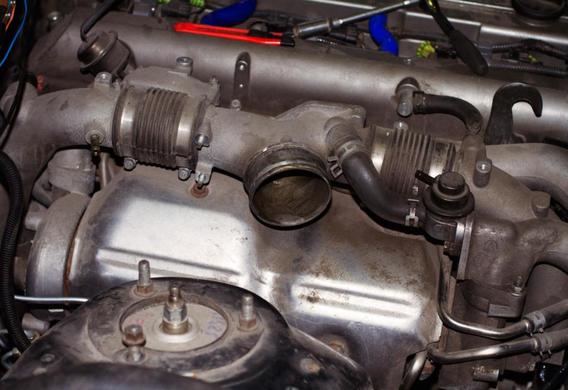
Turbocharging is a type of boost using exhaust energy to inflate the air into the engine cylinders. This principle was patented in 1911 by the Swiss, Alfred Buhi, in a patent office in the United States. In spite of the development of the turbines at the end of the 19th century, the mass use of this scheme began only in the 1970s. Although all the systems of the car are constantly being improved, the mechanical injection units developed over a century ago do not retreat. The tolerances in production are reduced, the accuracy of manufacture is increased, more technology materials and alloys are used (e.g. Nissan Skyline GT-R 34 version of the injection of the injection device made ceramic), so the turbo turbo capacity is still far from being exhausted.
Differences between bi-turbo and twin-turbo and confusion
Often even experienced and forged not only theoretically, but also practically people think that twin-turbo (twinturbo) and bi-turbo-only variants of the same scheme of inflatable engines with two turbines. Thus, commercial names, as with the names of full-transmission systems by different manufacturers (the same German producers: quattro-from Audi, 4matic Mercedes, have one point-complete transmission). In confirmation of the boost names, the example of Mitsubishi 3000GT in the VR-4 version carries the engine inscription "twin-turbo", there are V6 and two turbines, each has its 3 cylinders and has a common collector, the same pattern on the Aodi model S4 or Allroad from the 2.7 litre under the bonnet is the name of the bi-turbo. However, the name does not always display a pattern of work for a turbine (parallel or sequential, it is also sequenced. The same confirmation was confirmed in the circles of Japanologists 2JZ-GTE, set up by the Toyota Supra, which became known after the film "Fast and Furious", in which the main hero driving a bright red car, "made" Ferrari. The six-cylinder engine is also responsible for the twin turbo-turbo, and the turbines are operated by their own algorithm, which are operated and shut down by special transfer valves (parallel circuit). Subaru Lugaci B4-there are two turbines, and they work sequenced: one is a small turbine at low turnover, and the second one-the big one connects to it. One can argue with the use of such terms as twinning, dating, but not leaving the main topic.
The names of these systems created a popular misconception whose roots go from the word of education. twin-from the English-double or twin, i.e. the same boost-pressure mechanisms (or as they say in the "snail drivers" environment, meaning the similarity of these units with the same name of the same name), while the German-turbo is a system with two turbines. It turns out that there is a twin turbo turbo in a Japanese automobile, which traditionally uses the English terms for the names, while German automations use the names in their native language. That's why you're not going to meet the "B-turbo" studyin 'Toiote Supra, but' Twin ' on the Mercedes Benz.
The Bi-turbo Serial and its advantages
Bi-turbo (bi-turbo) is a sequenced or serial super-pouting system, that is, the exhaust system of internal combustion engine, which consists of two consecutive turbines. The system uses two turbines, one smaller size. This is done to ensure that the small turbine, which is spinning significantly faster, comes into operation first, provides good traction at a lower turnover, then, when higher engine speeds are reached, the second large turbine is swayed, and the volume of the air is considerably increased. Such a scheme, first, reduces the so-called turbo (or turboyam-that is, driving a car with the injection off), forming a more equal dynamic characteristic of the machine, without too much pressure, which is typical of a single large turbine or multi-injection system, which makes it possible to use large engines in the cars used not only for racetrack cars, but also leaving the possibility of driving on public roads when there is no possibility, and often The need to maintain high engine speeds. It is not worth forgetting that the excess capacity in the city is a very dangerous factor, since the dynamics of the prepared car not only has a high probability of "overtaking" the neighboring, usually the less agile car, which is next to the stream, as in the case of braking more often to look back, since the characteristics of the brakes on civilian cars are inferior to that of sports.
Turbocharged systems can be installed on both petrol and diesel units. The first use of turbocharging is accompanied by the risk of detonation due to the sharp increase in turnover. Also, as a result of the higher exhaust temperature, the turbocharged system itself is heated, requiring additional cooling. In diesel units, turbocharging units do not have such problems. There's a lot more compression, and the shaft speeds are lower. As a result of the adiabatic expansion, the exhaust gas engine temperatures are 1,000 degrees and diesel motors are much less than 600 degrees. Therefore, the use of turbocharging on diesel units is simpler and more efficient.
The problem is that the turbocharger's rotor cannot be made more than the diameter of the turbine, the greater the moment of inertia. So even if the acceleration driver pushes the accelerator pedal faster than the atmospheric accelerator pedal, it will not get it, because it will have to wait until the engine collapse, but then the turbine's retina will have to dial the corresponding turns. So the turbine should be smaller in diameter. But the flow of air is also influenced by the lower blade speed, which is smaller than the rotor's diameter: the increase in turnover is limited by the limit of the materials used.
Interesting facts about the Bi-turbo Bi-turbo
In addition to the sequential boost of the Bi-turbo in the cars, more complex circuits are used with a large number of chargers. For example, in the noisy Bugatti Veyron, 4 turbocharger is used to get power in 1001 horsepower.







